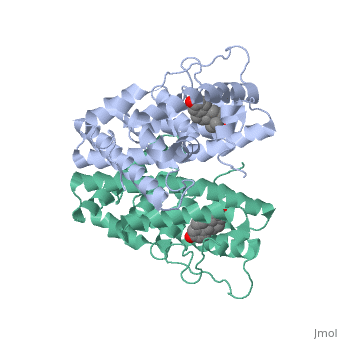This is a default text for your page Ivan Koutsopatriy estrogen receptor. Click above on edit this page to modify. Be careful with the < and > signs.
You may include any references to papers as in: the use of JSmol in Proteopedia [1] or to the article describing Jmol [2] to the rescue.
There are two flavors of estrogen receptors. ER - Intracellular receptor and GPER – G protein coupled receptors. ERs are transcription factors while GPER are not transcription factors. ERs are the focus of this page.
Function
Like other steroid hormones estrogen effects the transcription of a large number of genes via its interactions with its intracellular receptors, estrogen receptors. Estrogen receptors are receptors that are activated by the hormone estrogen (Example of an estrogen; 17β-estradiol).
Structural highlights
ER is a modular protein composed of a ligand binding domain, a DNA binding domain and a transactivation domain. ER is a DNA-binding transcription factor. Unbound ER normally exists loosly around the nucleus; this is subject to change depending on a multitude of factors including cell type, progress through cell cycle and reception of cellular signals. When estrogen enters the cell and binds ER, ER will trans-locates and undergoes a conformational shift.[3] Ligand bound estrogen receptor associates more tightly with the nucleus.
The specific conformation of this tight loop creates part of the activation signal that will stimulate normal growth, as estradiol is a normal ligand for ER.
Ferutinine also causes ER to form a tight loop allowing stimulation of normal growth.
The conformation of ER bound to genistein has a loop which is not as tight as those found on ER with a complete agonist ligand.
Tamoxifen is a drug created to bind ER and inhibit the transcription factor activity of ER. Tamoxifen is larger than the normal hormone ER binds (estradiol); for this reason the activation loop is pushed into an inactive conformation. This blocks ER from giving the signal to grow.
DNA Protein Interaction and ER Regulation
ER is functional as a ligand-dependent transcription factor. (3) ER responds to both agonist and antagonist ligands and can associate with the nuclear matrix. The location of the receptor bound and unbound to ligand varies amongst different cell types. In general, an antagonist ligand will cause partial accumulation in the cytoplasm of a cell. The agonist ligand causes the translocation to the nucleus described above.
A group bound GFP to ER and studied the location of GFP-ER upon binding of agonists and antagonist ligands. (3) GFP-ER activates the reporter gene in a dose-dependent manner and shows additional activation in the presence of agonist ligand 17-bestradiol. ICI 182780, a pure antagonist for ER, completely inhibited GFP-ER activation of the reporter gene.
The group found that in the absence of ligand, the unoccupied ER is loosely associated with the nucleus.
Ligand causes a biochemical transformation into a complex that associates more tightly with the nucleus.
Before ER binds its hormone the receptor is part of a complex that has many chaperones that maintain the receptor in a steroid binding configuration. Post hormone binding the receptor dissociates from its original complex and binds to hormone responsive elements in chromatin. Gene expression is then regulated by interaction of DNA bound receptors with sequence specific transcription factors and general transcription factors which are mediated by co-activators and co-repressors. The arrangement of cis regulatory elements in a specific promoter or enhancer region and the current state of DNA sequences in nucleosomes determines the system of receptor interactions. Contingent upon the interactions occurring, the result may be induction or repression of transcription.
ERα-regulated gene expression involves interactions with cointegrators (ex. p300/CBP, P/CAF) that have the capacity to modify core histone acetyl groups. 2 ER’s DNA binding domain is ordered around two zinc ions that allow the receptors to bind as homodimers to palindromic DNA sequences in such a way that each homodimer links to one half of the palindrome.
1. Beato, M., Chavez, S., and Truss, M. (1996). Transcriptional regulation by steroid hormones. Steroids 61: 240–251.
2. Wang C, Fu M, Angeletti RH, Siconolfi-Baez L, Reutens AT, Albanese C, Lisanti MP, Katzenellenbogen BS, Kato S, Hopp T, Fuqua SA, Lopez GN, Kushner PJ, Pestell RG (25 May 2001)."Direct acetylation of the estrogen receptor alpha hinge region by p300 regulates transactivation and hormone sensitivity.". J Biol Chem. 276 (21): 18375–83.
3. Htun H, Holth LT, Walker D, Davie JR, Hager GL (1 February 1999). "Direct visualization of the human estrogen receptor alpha reveals a role for ligand in the nuclear distribution of the receptor". Mol Biol Cell 10 (2): 471–86.
This is a sample scene created with SAT to by Group, and another to make of the protein. You can make your own scenes on SAT starting from scratch or loading and editing one of these sample scenes.

